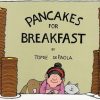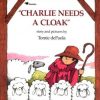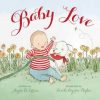Story Summary
Bearymore is a performing circus bear with a problem. After the last show of the season the ringmaster tells Bearymore he must have a new act when the circus opens again in the spring, but how can he think of an idea for his new act while hibernating all winter?
Talk Before Reading
With Bearymore, the conversation starts when you pick up the book. The cover illustration with Bearymore on his unicycle begs you to ask the question: What in the world is this bear riding? If your child has never heard of a unicycle, make a comparison to a bicycle. This looks a little like a bicycle, but I think something is missing! [A second tire and handlebars.] Tell me what you think would be hard about riding a unicycle. Use questions to help a child relate information on a familiar topic to a completely new idea. Connecting a new idea to an old idea helps the new information to stick.
Talk While Reading
Hibernation is mentioned on the first page of the story: He planned to go into hibernation, as he did every year. Ask your child to say “hibernation”–it’s a fun word! The meaning of hibernation–Bearymore-style–unfolds as the story progresses. He gets his nightshirt, tucks himself into bed, and sets his alarm for April. He posts a sign: Do not disturb. I am hibernating.
Good books always demand more than one reading. Repeated readings of Bearymore may give a chance to talk about the hibernation of real bears and other animals. My opinion: the mix of the pretend and the real in this story won’t be any problem to a child when you use it as a segue to talk about animals. Did you know that some animals really do hibernate? Where do you think a real bear might like to hibernate? [Your child might have some ideas on this. If not, give some prompts.] Do you think a real bear in the woods would put on his nightshirt before he started his hibernation, like Bearymore did?
You might think the nightshirt question is silly, and you would be right–it is silly! That makes it fun, but there’s a purpose to this kind of question: it gives a young child a chance to draw the line around real–as distinct from pretend–and consider a new question at the same time: Do bears wear nightshirts? Plus having a few giggles never hurts!
A few other phrases from Bearymore that could be conversation starters:
…took his nightshirt off the laundry line…
…wound up his old-fashioned phonograph and put on a record of lively circus music.
Days and weeks and months passed slowly by.
Bearymore started to do this with the greatest of ease...
…he glanced down, and saw his reflection in the water.
Don’t be obsessed with finding every possible phrase that could become a conversation, but think about the words your child may not know. For example, the laundry line becomes an important part of the story and many young children today have never heard of such a thing. When reading this story to a child, I might ask if he knows what a laundry line is, then say: My grandma had one, but she called it a clothesline. I used to help her carry the wet clothes in a basket to the backyard, so we could hang up the clothes to dry in the breeze. Another elaboration could be: We don’t use a laundry line to get our clothes dry. We use a…what? (Let your child say “dryer.”)
Talk Later
It’s funny how many times you’ll talk about something with your child, then hear the same topic elsewhere soon after. The next time you hear the word “hibernation”, turn to your child and say: Hibernation! That reminds me of…. Let your child chime in with “Bearymore!” Help your child link to his new knowledge.
The vocabulary, problem-solving and science connection make this story a rich talking experience. Don’t be surprised if at bedtime after reading Bearymore, your child asks to hang a sign from his doorknob. Do not disturb. I am hibernating.
Book
Bearymore by Don Freeman. Puffin, 1979. (Originally published in 1976.)




